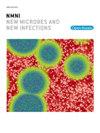首次从巴西梅亚庞特河和污水中分离出耐甲氧西林金黄色葡萄球菌(MRSA):对1198株分离物的分析
IF 5.4
Q2 INFECTIOUS DISEASES
引用次数: 0
摘要
目的检测巴西中部地区耐多药金黄色葡萄球菌和耐甲氧西林金黄色葡萄球菌(MRSA)的环境储存库。方法采用Baird-Parker琼脂培养膜过滤法,从某污水处理厂出水和塞拉多重要河流地表水中分离金黄色葡萄球菌和MRSA。在STP的两个点(预处理和后处理)收集出水样本。地表水是从梅亚庞特河从源头到河口的六个地点收集的。于2022年在所有这些收集点采集空气样本,在旱季和雨季之间共进行了4次活动。在所有运动的所有收集点均分离到金黄色葡萄球菌,共分离到87715株。在选择的1198株分离株中,83株对头孢西丁(FOX)耐药,表明耐甲氧西林表型。对83株fox耐药菌株的抗菌谱进行了调查,其中88%可被认为是多重耐药金黄色葡萄球菌。在83株fox耐药菌株中,70%以上对克林霉素、红霉素和利福平耐药。在Meia Ponte河沿岸和STP内收集的18株菌株中证实了mecA基因的存在,其中15株表现出多重耐药表型。主成分分析(PCA)结果揭示了金黄色葡萄球菌分离株与城市化环境/STP以及抗菌素的存在之间的关联。结论本研究是巴西水体中MRSA存在的先驱,突出了城市河流中抗生素耐药性监测的迫切需要。本文章由计算机程序翻译,如有差异,请以英文原文为准。

First record of methicillin-resistant Staphylococcus aureus (MRSA) isolated from the Meia Ponte River and effluent in Brazil: an analysis of 1198 isolates
Objective
This study aimed to detect environmental reservoirs of multidrug-resistant Staphylococcus aureus and methicillin-resistant S. aureus (MRSA) in Central Brazil.
Methods
Membrane filtration with growth on Baird-Parker agar base was used to recover S. aureus and MRSA from the effluents of a sewage treatment plant (STP) and surface water from an important Cerrado river. Effluent samples were collected at two points in the STP (pre- and post-treatment). Surface water was collected at six points along the Meia Ponte River, from its source to the mouth. Air samples were collected at all these collection points in 2022, totaling four campaigns between the dry and rainy seasons.
Results
S. aureus was isolated at all collection points in all campaigns, totaling 87715 isolates. Of the 1198 selected isolates, 83 were cefoxitin (FOX)-resistant, indicating a methicillin-resistance phenotype. The antimicrobial profiles of the 83 FOX-resistant isolates were investigated, and 88 % could be considered multidrug-resistant S. aureus. Of the 83 FOX-resistant isolates, more than 70 % were resistant to clindamycin, erythromycin, and rifampicin. The presence of the mecA gene was confirmed in 18 isolates collected along the Meia Ponte River and inside the STP, with 15 exhibiting multidrug-resistant phenotypes. The results of the principal component analysis (PCA) revealed an association between S. aureus isolates and the urbanized environment/STP, as well as the presence of antimicrobials.
Conclusion
This study is a pioneer in identifying the presence of MRSA in Brazilian water bodies, highlighting the urgent need for monitoring antimicrobial resistance in urban rivers.
求助全文
通过发布文献求助,成功后即可免费获取论文全文。
去求助
来源期刊

New Microbes and New Infections
Medicine-Infectious Diseases
CiteScore
10.00
自引率
2.50%
发文量
91
审稿时长
114 days
 求助内容:
求助内容: 应助结果提醒方式:
应助结果提醒方式:


